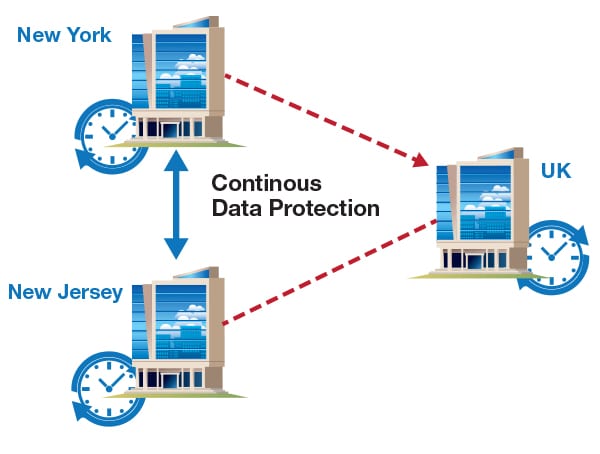In this article, we’ll discover the concept of continuous data protection and see the advantages of such a system. We’ll also look at how continuous data protection works, including types of data that can be backed up and CDP topologies.
We’ll see CDP benefits, such as its ability to record every write and copy to the target and its capacity to preserve a record of every data transaction, and its drawbacks, including the potential for single point of failure and increased load on data resources.
Read on to find out about how to protect your data with Cloudian.
In this article:
• What is continuous data protection?
• Near CDP vs true CDP solutions
• How does continuous data protection work?
• Benefits and drawbacks of CDP backup
• Data protection with Cloudian
Note: This article is a part of a series on Data Protection.
What Is Continuous Data Protection?
Continuous Data Protection (CDP), also called continuous backup, is a system that backs up data on a computer system every time a change is made. CDP maintains a continuous journal of data changes and makes it possible to restore a system to any previous point in time.
This solves the problem of the “backup window”, where organizations are at risk of losing data created between two scheduled backups. It also provides powerful protection against threats like malware and ransomware, as well as sabotage or accidental deletion of data. This may be necessary for compliance with stringent data protection regulations.
Near CDP vs True CDP Solutions
There are two types of CDP solutions:
- True CDP—actually backs up data with every change. This allows an organization to achieve a Recovery Point Object (RPO) of zero.
- Near CDP—a regular backup system, but one which runs scheduled backups very frequently, so it is close to achieving the effect of continuous data protection. RPO will be higher than zero, and equal to the interval between scheduled backups.
How Does Continuous Data Protection Work?
Continuous data protection copies the “delta”, any changes to your data, from source to target. True continuous data protection systems record every write and store it in a changelog on the CDP system. CDP keeps all changes until the last write before failure, allowing you to restore to that point or any previous point before the data was corrupted or lost.
Types of data that can be backed up
Continuous data protection systems can record and back up changes to any type of data:
- Files in your file system
- Application data and files
- Databases
CDP Topologies
It is common for the target disk to be in the same network as the source, allowing users to perform quick recovery of data. Another topology is off-site replication, which provides better protection but also introduces higher latency.

Continuous Data Protection with remote replication
Some CDP solutions allow you to replicate to two locations, one on-site for rapid recovery and another off-site for disaster recovery scenarios.
Benefits and Drawbacks of CDP Backup
Continuous data protection is a powerful concept that can help organizations achieve secure data storage. However, it also raises several operational challenges.
Continuous data protection benefits:
- Records every write and copies to the target—changes are stored in a log, allowing you to “replay” the data from any point in time.
- Preserves a record of every data transaction—this is important for auditing and compliance, and for forensics in case of security incidents.
- Disaster recovery—continuous data protection is an important component of a disaster recovery strategy. For example, the continuous data protection backup store can be replicated at frequent intervals to a remote data center.
- Version control—continuous data protection keeps multiple versions of each file, allowing creators and users of data to roll back to previous versions.
Continuous data protection challenges:
- Disk-based—continuous data protection solutions require fast disk drives, which may require a significant investment in physical disk storage.
- Single point of failure—a continuous data protection server can become a single point of failure for the enterprise, so ensure you have high data availability in place.
- Increased load on data resources—continuous data protection effectively doubles data throughput, because every data transaction needs to be saved immediately to backup. The critical resources you will protect with continuous data protection are typically highly loaded anyway, so this may create performance or stability issues.
Data Protection with Cloudian
Continuous data protection requires powerful storage technology. Cloudian’s storage appliances are easy to deploy and use, let you store Petabyte-scale data and access it instantly. Cloudian supports high-speed backup and restore with parallel data transfer (18TB per hour writes with 16 nodes).
Learn more about data protection with Cloudian and view this vmLIVE video to learn how VMware, Veeam, and Cloudian deliver Ransomware Protection with Immutability.
